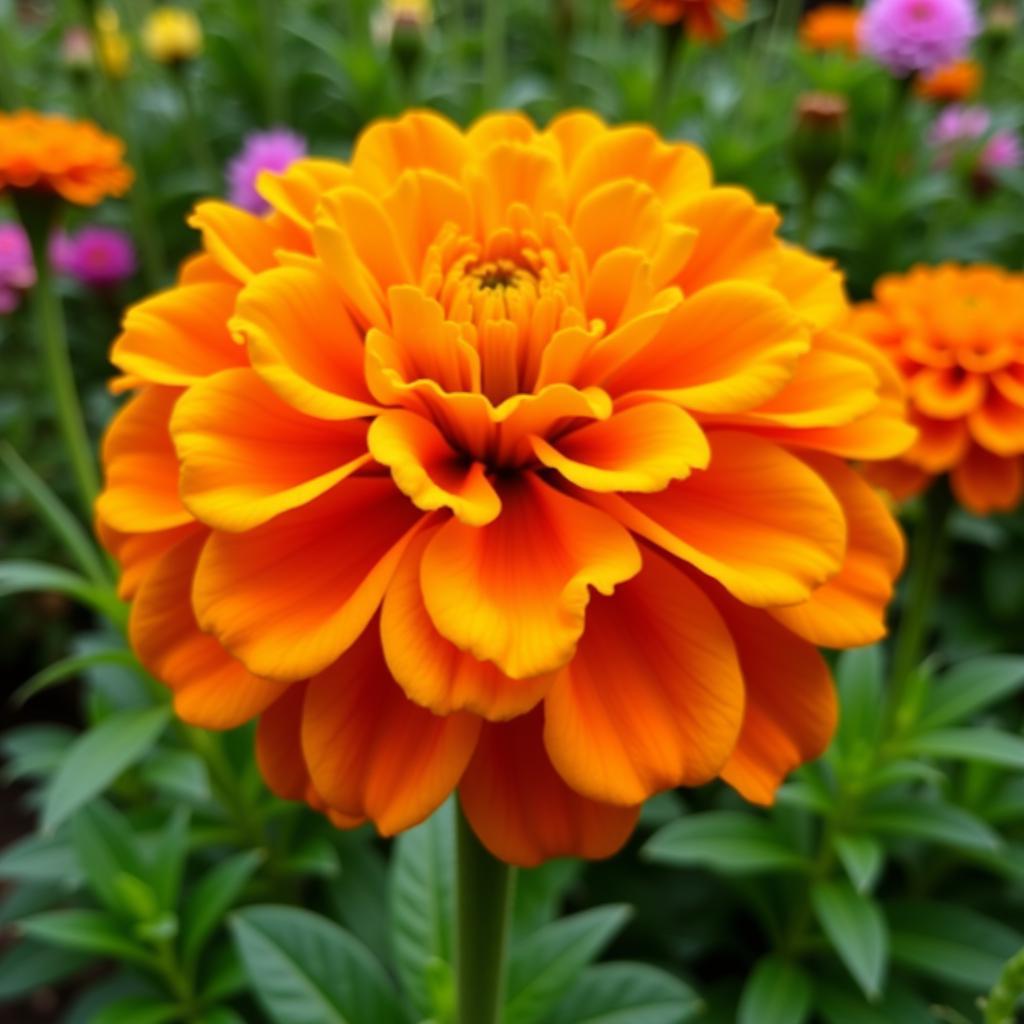Difference Between African Marigold and French Marigold
African marigolds and French marigolds – they both have the name “marigold” and bring bursts of vibrant colors to gardens, but did you know these popular flowers are not that closely related? While they belong to the same family (Asteraceae), they are different species with distinct characteristics that set them apart. Understanding the Difference Between African Marigold And French Marigold can help you choose the perfect variety to complement your garden design and thrive in your local climate.
Decoding the Differences: A Closer Look at Each Variety
Let’s delve deeper into the individual traits of African marigolds and French marigolds:
African Marigold (Tagetes erecta): Bold and Majestic
Known for their impressive size and large, globe-shaped blooms, African marigolds, also called American marigolds, make a grand statement in any landscape.
-
Size and Growth: African marigolds typically grow taller than their French counterparts, reaching heights of 1 to 4 feet. They have a more upright and sturdy growth habit.
-
Flowers: Their blooms are their claim to fame. Large and round, the flowers can span 2 to 5 inches in diameter, resembling fluffy pom-poms. They come in warm, sunny shades of yellow, orange, and gold.
-
Scent: While not as pungent as French marigolds, African marigolds still have a distinct, musky scent, which some find less appealing.
-
Uses: These majestic flowers are excellent for adding height and drama to flower beds and borders. They are also commonly used as cut flowers for their long vase life.
 African Marigold in a Garden
African Marigold in a Garden
French Marigold (Tagetes patula): Compact and Versatile
Don’t let their name fool you – French marigolds actually originated in Mexico and Central America. These charming flowers are celebrated for their compact size, making them ideal for smaller gardens or container planting.
-
Size and Growth: French marigolds typically grow between 6 to 18 inches tall, maintaining a bushier, more compact form than their African relatives.
-
Flowers: French marigold flowers are smaller than African marigold blooms, typically measuring 1 to 2 inches in diameter. They offer a wider range of colors, including yellow, orange, red, mahogany, and bicolor patterns.
-
Scent: French marigolds are known for their strong, pungent scent – which can be a pro or con depending on your preference! This potent fragrance makes them effective companion plants for repelling certain garden pests.
-
Uses: Their compact size and vibrant colors make French marigolds perfect for edging flower beds, adding pops of color to containers, and even as ground cover in sunny spots.
African Marigold vs. French Marigold: Key Distinctions
Here’s a quick comparison table to highlight the key differences between these two popular marigold varieties:
| Feature | African Marigold | French Marigold |
|---|---|---|
| Scientific Name | Tagetes erecta | Tagetes patula |
| Origin | Mexico | Mexico and Central America |
| Size | Tall (1-4 feet) | Compact (6-18 inches) |
| Flower Size | Large (2-5 inches) | Small (1-2 inches) |
| Flower Shape | Globe-shaped | Single, semi-double, or double, often with ruffled petals |
| Color | Yellow, orange, gold | Yellow, orange, red, mahogany, bicolor |
| Scent | Musky, less intense | Pungent, strong |
| Uses | Borders, cut flowers | Edging, containers, ground cover, pest repellent |
Choosing the Right Marigold for Your Garden
Ultimately, the best marigold for your garden depends on your personal preferences and the specific needs of your outdoor space.
“When deciding between African and French marigolds, consider the scale of your garden,” advises Dr. Abeni Olufemi, a renowned botanist specializing in African flora. “The larger blooms and taller stature of African marigolds lend themselves well to spacious borders, while French marigolds, with their compact habit and diverse colors, offer versatility for smaller gardens and containers.”
Frequently Asked Questions About African and French Marigolds
1. Do African and French marigolds need full sun?
Yes, both African and French marigolds thrive in full sun, ideally receiving at least 6 hours of direct sunlight daily.
2. Are African marigolds perennial?
No, both African and French marigolds are annuals, meaning they complete their life cycle in one growing season.
3. When is the best time to plant marigold seeds?
Marigolds are best sown directly outdoors after the last frost has passed and the soil has warmed up.
4. Do marigolds attract pollinators?
While not as attractive to bees and butterflies as other flowers, marigolds can attract beneficial insects like ladybugs and lacewings that help control pests.
5. How often should I water my marigolds?
Water your marigolds regularly, especially during dry periods, ensuring the soil remains moist but not waterlogged.
6. What are some common problems that affect marigolds?
Marigolds are generally low-maintenance but can be susceptible to issues like aphids, spider mites, and fungal diseases, particularly in humid conditions.
7. Can I grow marigolds in pots?
Yes, French marigolds are particularly well-suited for container gardening due to their compact size. Choose a pot with good drainage and use a well-draining potting mix.
Explore More about Marigolds and Other Garden Delights
Want to delve deeper into the world of marigolds and discover more about creating a thriving garden? Here are some other resources you might find helpful:
- Article: The Ultimate Guide to Growing and Caring for Marigolds
- Article: Companion Planting with Marigolds: Natural Pest Control for Your Garden
- Article: 10 Stunning Marigold Varieties to Brighten Your Garden
For any assistance with your gardening needs, contact us at +255768904061, email kaka.mag@gmail.com, or visit us at Mbarali DC Mawindi, Kangaga, Tanzania. Our dedicated customer service team is available 24/7 to help you create the garden of your dreams.




